Which of the Following is Not Included in the Definition of Continuous Process Improvement Cqi
The Essential Guide to Continuous Quality Improvement
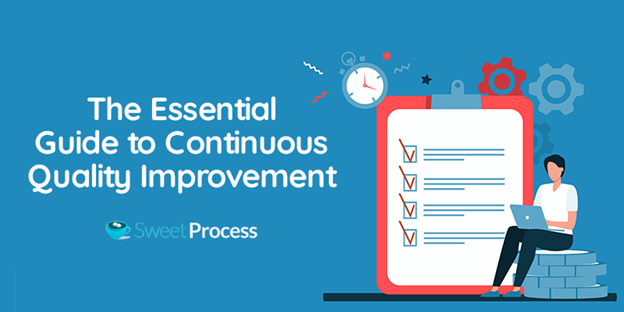
Featured Bonus Content: Download the FREE Checklist for Continuous Quality Improvement! Click Here To Download It.
Let's say you run a business where you make customized jewelry. You take orders and make deliveries every two days. But even after years of work, you notice you don't always deliver on time and even mix up orders. You have to start over again to get the details right. You've lost time and resources, and now your customers are upset.
You don't want to go out of business, so now you're looking for ways to improve your process so the products exceed expectations for the customers. What you need is a continuous quality improvement strategy.
Continuous quality improvement (CQI) is a means for attaining quality in various endeavors. It helps you understand what you're doing and how to improve on it. It builds on quality to attain higher standards. Humans are constantly improving who they are and what they do to be valued more. Most people only think and wish to be better, yet only a few act on their desires and achieve their goals.
But how can you make sure that your changes follow the rules of CQI?
This article covers what you should know about continuous quality improvement and why you need it if you're aiming to hold the market. It has been divided into the following parts.
Chapter 1: Definition and History of Continuous Quality Improvement
Chapter 2: How to Implement CQI
Chapter 3: Components of CQI Culture
Chapter 4: Importance of Continuous Quality Improvement
Chapter 5: Methods of Continuous Quality Improvement
Chapter 6: Best CQI Methods to Use
Chapter 7: Barriers of CQI
Chapter 8: Using SweetProcess on Your CQI Journey
Conclusion
Chapter 1: Definition and History of Continuous Quality Improvement
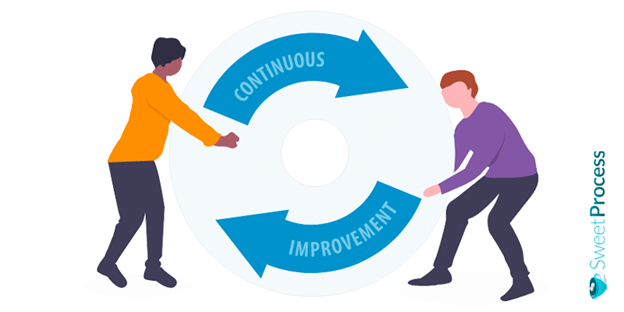
Continuous quality improvement (CQI) is a process that ensures that something doesn't have to go wrong before you fix it. It lets you foresee a problem and deal with it before it happens. This process is data-driven (it uses data to instruct changes) and involves the contribution and collaboration between employees at all levels of an organization and management. Continuous quality improvement is a deliberate act to see that programs are constantly improving. It lets you serve your customers better.
CQI encourages members and owners of organizations to look for ways to foster a learner production and create an environment of continuous change and adaptation. It acknowledges that problems are caused by processes, not people. Hence, it discourages fear and blame in the employee hierarchy. In CQI, quality is achieved when you meet or exceed the needs of customers. This can be achieved by monitoring service quality and customer satisfaction by using valid data and getting feedback.
CQI was first developed in the 20th century by Walter Shewhart. He developed it as a means of addressing procedural problems before mistakes could harm products. His statistical process control can be traced to the 1920s and 1930s as the beginning of CQI. His method enabled employees to track changes in processes and product output using a chart. This method let them fine-tune work as it was completed.
Walter's student W. Edwards Deming refined his concepts, landing finally at what we now know as continuous quality improvement. He was influenced by Walter's Shewhart line. The Shewhart line was a three-step scientific process of specification, production and inspection. Deming reasoned that results would be better if the steps were in a cycle rather than a straight line. The Shewhart line then became known as the Shewhart cycle. In 1950, Deming further improved on Walter's idea and created a new version known as the Deming wheel or cycle. This concept's newest modification is now known as the PDCA cycle.
CQI is mostly used in healthcare, social services and education. However, it is not limited to be used by these structures since its framework can be employed by any organization. The successful implementation of CQI is a long process. Learning about its benefits will encourage you to put in the needed work in your organization to see improvements.
Chapter 2: How To Implement Continuous Quality Improvement
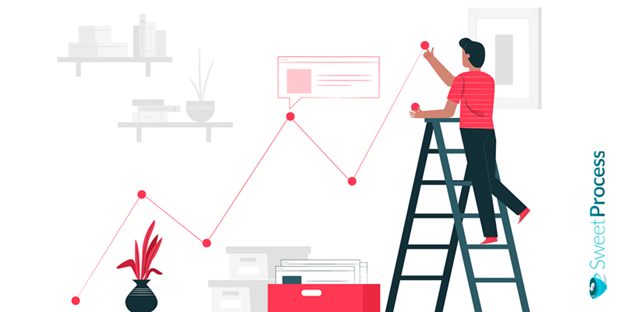
To Implement continuous improvement in your organization, you should consider the following:
- A culture of quality in your work environment should be set in place and fully established.
To begin your CQI journey, you should let your workers know what you're expecting and how they are to perform. They will need to have a culture of CQI (as you'll learn in the next chapter).
- Assign employees to quality improvement teams and hold weekly, monthly or quarterly quality improvement meetings.
Create a team in charge of your operations for change. Teams should meet regularly to create and restructure policies using available data.
- Look at areas needing improvement, determine a strategy and then arrange them according to priority.
Consider what areas your business is lacking in and what can be done to improve on it. What CQI strategy you'll use is dependent upon your areas of concern.
- Collecting and analyzing data needs to be done regularly.
To see how far you've come, how you're doing and where you're going, do well to always take data at each step of the way. It is effective in learning what is working and what isn't.
- Have data showing how the situation was before you begin a new project.
This is important as it lets you have a better understanding of how things used to be and what they are like now that you've begun the process of change. Having data at hand makes it easier to track and adjust changes.
- Communicate your results to those involved.
Employees should always report observations to those heading your QI team. They have to be conscious and alert to not miss any change as it happens.
- Everyone in your organization should be involved in this process.
CQI is about teamwork. Promoting an individual is not the goal. Every employee and management work together to achieve a goal. Include your customers in this process by getting their feedback on your products and services.
- Remain committed.
As you'll learn in this article, continuous quality improvement is a process that should not end. Results from whatever CQI method you choose to use may not be immediate. However, if you remain committed, you'll like what you'll be getting.
Chapter 3: Components of CQI Culture

CQI has some core principles which it is noted for, all of which have to be present in the work environment and imbibed by the workers for it to be said that it has a culture of CQI. Watch Mark Anderson describe what makes a CQI culture.
- Understanding customer needs. The need of the customer is the primary reason for improving quality. CQI is driven by the need to see how customers can get the best service from an organization: how to have satisfied customers, how to reduce complaints and bad reviews. So whatever improvements you're working on should stem from the perspective of the customer. Get feedback from customers to know how you can improve your services.
- Use of statistical analysis to identify problems and strengths. Continuous quality improvement is a data-driven process. It relies on data that has been collected for decision-making and to effect needed changes. This is why undertaking a CQI project is intentional. It is not just guesswork with CQI; real experiments are conducted and live results are produced.
- Teamwork and empowered employees. Employees should be encouraged to identify areas for improvement. CQI is not solely the job of management. The fact is, the employees often notice waste, customer needs, and what area changes need to happen. As they are involved in the process directly, they may likely have input on how a process can be improved. Therefore, equip your employees with the right tools. CQI can only be as successful as your team's efforts. They work as a team to achieve a goal rather than just getting work done.
- Continually improve organizational processes. Big changes come from small efforts. Working at things one step at a time is how a total change can be achieved. It doesn't promote mediocrity or complacency. Therefore, the bars of quality continue to be set higher. Errors are seen as opportunities for learning and failures are understood to be bound to happen but it shouldn't stop you.
- Leadership support and commitment. CQI is an all-inclusive process, meaning no one should be left out, including management. The necessary support should be given to team members to foster an environment of quality improvement.
- Use employee reward and recognition. Engagement should be by all members at all levels. As employees do so, respect people for their input. As a way to make participants more active, place rewards for whenever a good idea is suggested. Note that data in CQI should not be used to judge others.
- Communication. Communication is important in any organization, more so in one wanting quality improvement. CQI encourages good communication across team members. Personal observations on what can improve processes and procedures should be communicated to the right people.
- Define your goals. Defining your company's long-term and short-term goals is the very first step in beginning a continuous quality improvement process. Knowing why your company exists and what it aims to achieve should be known by your employees. Work can then start with improving quality in the necessary areas.
- Documenting. Data collection is another core principle of CQI. As this is not a venture that gets done in a short time, data must be kept properly on the journey. Suggestions, observations and results should be collected and recorded correctly. This forms the basis for knowing what changes to implement.
Chapter 4: Importance of Continuous Quality Improvement
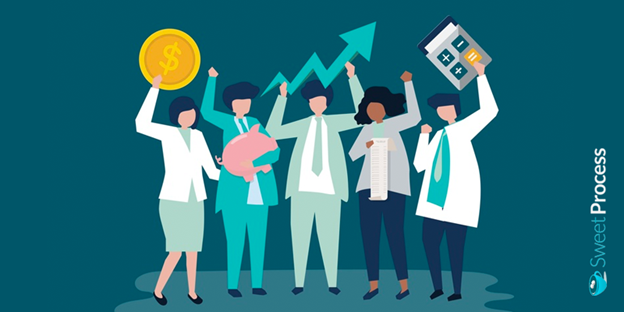
Research has shown that more people die in hospitals from mistakes than from natural causes each year. In other sectors such as finance, time, output, inventory, customer satisfaction and others, mistakes might not be as fatal but they can cause some serious drawbacks to various aspects of an organization. A CQI prevents these from happening by improving the quality of processes and procedures. Other benefits of CQI include:
- It improves customer satisfaction. Whatever business you run, you're there because of your customers. Without them, you wouldn't have a business. You want to treat them well and make them feel that they're getting the best service from you. Using the principles of CQI, you're constantly looking for ways to improve to better serve your customers. CQI looks for where there's a lapse and it covers it up. And it does this from the customers' perspective. Because you have a culture of CQI, you're open to suggestions from your customers and even have foresight on what to do to avoid future problems. Happy and satisfied customers tell your organization's story better.
- Reduces defects. Employing CQI practices in your business means you're always looking for room for improvement in your organization. CQI is more about being proactive rather than reactive. In other words, before a problem arises, one has already anticipated and corrected it. It gives better results and reduces errors, making you turn out higher quality products. Almost nothing can catch you by surprise.
- It makes team members accountable. Giving team members roles and responsibilities builds accountability in the work environment. Making them conscious of how they can improve on what they do will bring positive rewards. CQI builds a learning environment and places workers in their best forms. Employees working in an environment where they are expected to make continual improvements perform better at their jobs.
- Reduces costs and improves profit. CQI eliminates waste and redundancy. This automatically improves profit while reducing the cost spent on rectifying errors. CQI is not prescriptive. It lets you think about what to do to make a good change. And as you implement the systems to get more done in less time, you save money on labor. Your offerings will have fewer flaws since time and energy are spent resolving problems.
- Increases creativity and solution creation. With a culture of CQI in your organization, you'll learn the importance of getting everyone involved in the quality improvement process. When this culture is successfully understood and there is a reward for bringing good ideas, creativity will be high.
- It creates a continuous learning environment. When there's constant learning, growth is achievable. As CQI is about seeing how to improve on what you do, it makes members constantly look for ways to improve on processes they're involved with. It puts the consciousness of "we grow together" in everyone. When there is an area spotted for improvement, it is shared and ideas are passed and then the best ones get executed.
- It improves agency processes, procedures and functions. Continuous quality improvement helps you figure out what works for you. From that point on, you're looking for ways to improve on what works and remove what doesn't. This ensures a smooth running of your processes
Chapter 5: Methods of Continuous Quality Improvement
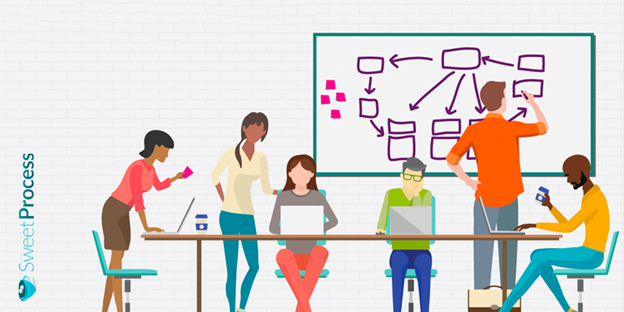
Numerous methods for improving quality in an organization abound. Five methods are commonly used more than others. The major methods of continuous quality improvement are listed below and discussed:
- PDCA
- Model for Improvement
- Lean Methodology
- Six Sigma Method
- Malcolm Baldrige Quality Award Methodology
PDCA
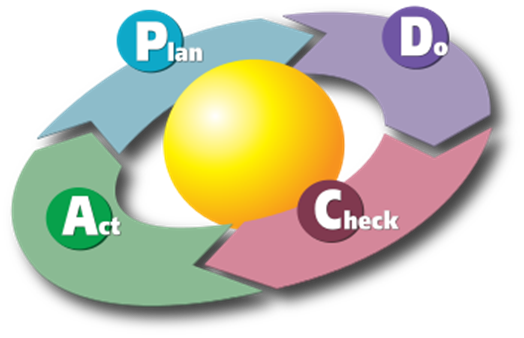
The PDCA method for continuous quality improvement was developed by W. Edwards Deming. (also known as the Deming method). It is an established tool for achieving continuous improvement. It involves testing possible solutions, assessing the results and pushing forward the ones that worked. It breaks down the process into smaller steps and explores ways to improve each one of them. It is a four-step cycle for problem-solving. The steps are: plan, do, check and act.
Plan: Here, goals are set and actions needed for change are determined. Information about current processes and customer needs is collected and analyzed. This is a three-part step involving the identification of the problem, analyzing it and developing an experiment to test it.
The roles of individuals will be given as well as a timeline for completion of each task. You recognize an opportunity and plan a change.
Do: Carry out a small-scale study to test your potential solution. As the plan is put into action, document your findings. This documentation should include any issues and unexpected occurrences.
Check: Analyze findings and document lessons learned after implementation. Information is looked at to see if goals have been achieved. Check whether your ideas were successful as you compare with your expectations.
Act: Take action based on what you learned in the study/check step. After checking your findings, determine what actions need to be taken to improve on your already existing processes in the long run. If the desired goal was achieved, the newly created process should be added as part of the organization's routine.
The PDCA method is an unending cycle. So in the last part, (act), you repeat the process if it didn't work out the first time or for even better results. Due to the long time frame for applying this method, it may not be the most appropriate approach for dealing with an urgent problem.
When should you use the PDCA cycle? You should consider using this methodology when:
- You intend to start a new project.
- You're improving on your processes.
- You're looking for the root causes of problems.
- You want to implement any change.
- You want to define workflows.
- You plan to continuously improve.
Model for Improvement
This method for improving quality makes an organization clearly define its goals. This model was created by the Institute for Healthcare Improvement Collective to address social problems. This model employs the PDCA method and asks three fundamental questions. By asking these three questions, it guides the organization on the proper steps to take.
- What are we trying to accomplish?
- What changes can we make that will result in improvement?
- How will we know if a change is an improvement?
In the first question, your company's goals and objectives are outlined clearly. This gives you the means to know when a process is working in line with your goals. It also ensures that everyone is working toward the same goal. After you've identified the problems that need solving, make a plan to change them. The plan should be specific, timebound, aligned and quantifiable. It is hard to change what you can't measure.
At the second question, ideas on how to improve are brought and plans to execute it formed. It encourages team members to identify specific changes that can be tested readily. Not every change suggested will lead to an improvement in quality. According to your goals, you should be able to tell if a change was successful or not. Setting up measurements at each stage lets you determine this.
At the third question, track your progress against your target to know how successful a change has been.
When combined, the three questions and the PDCA cycle form a framework to support continuous improvement. It is based on the five principles of improvement. These are the five principles:
- Know why there is a need to improve. What problems you're facing guide you on the steps to take.
- Interpreting improvements through measurements, i.e, keep track of the changes you're implementing.
- Creating an effective change theory that will result in improvement. Steps taken to improve processes should be efficient in affecting the needed change. Suggestions should be studied before they're carried out.
- Testing a change before implementation. You don't want to stamp a theory without trying it out on a small scale first. Study the results to determine if a process should be implemented in your organization.
- Knowing when and how to implement a change. The moment you notice a problem is the time a change is needed. How to implement the change depends on the problem and what you're aiming to achieve.
Lean Methodology
The Lean method focuses on removing wastes in ongoing processes. It was developed by Toyota Corporation to improve value to customers and employees while reducing waste. It outlines seven types of waste: transport, inventory, motion, waiting, overproduction, over-processing, and defects. Using this model as a method for continuous quality improvement ensures that more time is spent performing value-added tasks. This is possible because overburden and inconsistency are reduced to create a process suitable for delivering the required results. This method identifies valuable processes and those that are not. Lean focuses on increasing customer value while optimizing operations. It sees that workflows and tasks are efficient and effective. Value is looked at from the customer's point of view. You deliver what the customer needs when they need it. While doing this, use as few resources as possible so there is no waste. It involves building a culture that respects all employees and enables them to share ideas for continuous improvement.
Six Sigma Method
This model was developed at Motorola by Bill Smith. It goes with the Lean model. It is used to find and eliminate causes of problems and variations in process and output. It recognizes that defects are the fault of processes. It aims to reduce the rate of error in processes. Using this model, processes and outcomes to be improved are defined, performance is tracked through data collection, processes are analyzed to know how they're doing, and results are improved.
This model ensures that processes that add no value are cut out. Error elimination is the goal of Six Sigma. It tries to reduce the possibility of errors to the barest minimum. Six Sigma stands for the Greek letter sigma which is a statistical symbol that represents a standard deviation. It is used because a Six Sigma process is expected to be correct 99.99966 per cent of the time. This only gives room for a 3.4 defect for every million opportunities. According to Ssix Sigma, processes that do not satisfy the customer are seen as a defect and should be removed from the system to ensure superior quality of products and services.
Six Sigma is designed to suit large organizations having quality management problems. A sequence of steps is defined around a particular target to achieve its target. It streamlines quality control for there to be as little to no variance as possible throughout the production processes. There are two methodologies of Six Sigma: DMAIC and DMADV.
The Six Sigma DMAIC
This methodology is used to improve a new product or process that doesn't meet expectations. The steps are simple to follow.
Define: Your goals and expectations, problems, customer expectations and project requirements are defined.
Measure: See how current processes are performing. Collect and record data to know areas of defects.
Analyze: Analyze your processes. Learn the causes of variations and defects to spot issues working against your current processes and final goal.
Improve: With knowledge of your processes defects, improve on processes based on what you have gathered in the previous stage. Create new projects that will ensure you have better quality.
Control: Take control of your new and established processes so it stays on track and does not become defective.
The Six Sigma DMADV
This method is also known as the design for Six Sigma (DFSS). It aims to create new ideas to help business processes.
Define: Set achievable goals regularly, suiting to the customers' requirements and your business strategy.
Measure: Measure and identify the customers' need for quality services and make them into project goals.
Analyze: Study various options for satisfying the customer while estimating the total life cycle of the project. Analyze high-level alternatives that'll ensure superior quality.
Design: Create a high-level process after which a more detailed prototype is created to identify errors and make changes.
Verify: Check that your final process is approved by all customers and clients. After verification, implement the process.
These two methodologies appear similar but they have a specific focus. While DMAIC focuses on improving existing processes to meet the customers' needs, DMADV focuses on creating new strategies and policies.
If you're going with the Six Sigma approach for continuous improvement, here's a few things to keep in mind:
- Your projects should have clear processes for inputs and outputs.
- Don't start the project with a solution in mind.
- Reduce operation variations to make it easier for untrained operators.
Malcolm Baldrige Quality Award Methodology
The Malcolm Baldrige Quality Award developed from an honor given to organizations to recognize quality as an approach that enabled continuous excellence. The award was established by the U.S. Congress in 1987 to raise awareness of quality management and recognize companies that have done so successfully in the country. It is known as the nation's highest presidential honor for performance excellence. This model aims to make strategic changes to an entire organization. It focuses on enterprise-level improvement through communication, productivity, and effectiveness. It is given annually in six categories: manufacturing, service company, education, healthcare, small business and non-profit organizations. Those who receive the award are selected based on achievements and improvements in seven areas known as the Baldrige criteria for performance excellence.
- Leadership: There is a check on how management leads the organization and how the organization in turn leads in the community.
- Strategy: How strategic the organization is in establishing and implementing directions.
- Customers: The organization's relationship with its customers; how the relationship is built and maintained.
- Measurement, analysis and knowledge management. How does the organization manage performance and key processes through the use of data?
- Workforce: What ways does the organization empower its workforce and involve them in its processes?
- Operations focus: How the organization designs, manages and improves its processes.
- Results: How is the overall performance of an organization's processes in areas such as finance, customer satisfaction and its competitors?
This model better suits an enterprise-level improvement rather than a single business. The man associated with this award, Malcolm Baldrige Jr, the late U.S. Secretary of Commerce, believed that quality was the key to prosperity and economic growth.
Chapter 6: Best CQI Methods to Use

Continuous quality improvement is not a one-size-fits-all venture. As the needs of companies differ, so will the solution to apply to a problem be different. You find out what suits your organization better and follow that. Take Six Sigma, for instance. It is better suited for big organizations having a minimum of 500 employees. Each method of CQI has its strengths that are better suited for a particular problem area. You might even need to combine methods to get what you want. What matters in the end is that you see your chosen method through to the end and not quit.
Chapter 7: Barriers of CQI
Before you begin the process of CQI, you must know that there will be some challenges ahead. Prepare yourself since some factors will resist the changes you're planning on accomplishing. Some of them are internal and others are external.
- Lack of commitment. Continuous quality improvement is an ongoing process. It is continuous. It means you're not going to be satisfied with the state of your work's quality and so you're looking for ways to be better. The moment you decide to quit in the middle, it defeats the aim of CQI. When people who have the responsibility to lead the quality improvement team are not consistent, the whole process falls back to base. Especially since results may not be seen immediately, it could discourage commitments.
- Limited resources. There are agencies whose heart is strongly toward seeing quality improve but there are not enough resources for it. Setting up a team, carrying out experiments, and getting extra equipment can be costly. Thinking about these sacrifices might make one pass up the idea to try out the process of continuous quality improvement.
- Time constraints. The time needed to execute CQI might be a luxury to some organizations where workers are not enough. Everyone might be too busy to even realize that there are areas where things could be done differently.
- New adjustments. Employees can have good intentions and improve quality at the workplace, but when it comes to implementing that change, it is difficult to break old habits. Unintentionally, they can find themselves doing things the way they've been told to avoid. It can be frustrating when people refuse to change old habits after it has been proven to be problematic. A determination to change will help everyone do the right thing. With time, they should drop the unhelpful practices and stick to the more efficient ones.
- People don't like change. While there are people who genuinely want to be better but are hindered from doing so for one reason or the other, there are others who are completely adamant to change. They can be difficult and myopic. They don't see a reason why things have to change from the way they've always been. Some feel that the old ways are better. If you have this set of people in your organization, implementing changes will be more than a chore. It'll be worse if those folks have been there for a long time. They may want to talk you out of doing things differently. Don't let them.
Take a look at this video to learn more about CQI and its barriers.
Chapter 8: Using SweetProcess on Your CQI Journey
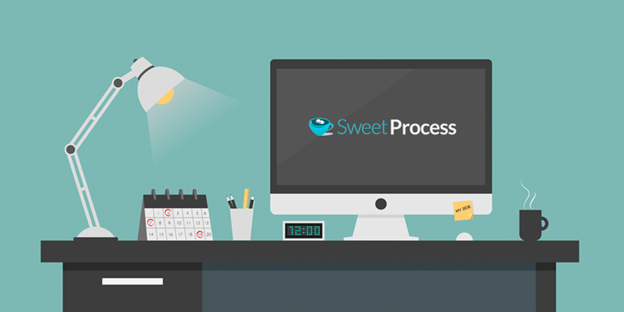
Before beginning your CQI journey, you should ensure that your processes and procedures are properly documented. Without having any idea of what your current processes are, making improvements is hopeless. Documenting processes and procedures gives you a starting point to look closely at what you've been doing and how you can improve on it. During your CQI journey, as you've learned, data collection is important. This is where SweetProcess comes in. SweetProcess is a software that has proven to be the tool organizations wishing to see good improvement in their day-to-day activities need over the years.
First, let's see how Ginkgo Residential was able to get its employees on the same knowledge level and increase employee efficiency using SweetProcess.
Sarah Genay, the portfolio analytics manager at Ginkgo Residential (a real estate company) was placed in charge of documenting the company's procedure. Knowledge wasn't distributed evenly in the company and it affected employee performance negatively. SweetProcess was the tool that made documentation of processes and procedures effective. While using SweetProcess, she also noticed that it made improving quality easier. The program allows everyone to be active in decision-making—a core aspect of continuous quality improvement.
Next, we see how Atlantic Sapphire, a salmon farming company, was able to streamline workflow using SweetProcess.
Stanley Kolosovskiy, the technology process coordinator at Atlantic Sapphire, was in charge of making sure that the organization's business operations were optimal. As a company interested in delivering products to customers without polluting the environment, employees had to comply strictly with operating procedures. But this wasn't happening the way Stanley liked because an effective workflow system was missing.
SweetProcess was what the company needed and it proved itself as a system for documenting processes and procedures that employees would use. Unlike the hard-to-use ones, SweetProcess is user-friendly and employees are not daunted when referring to it. The company experienced for itself how thorough this software is in capturing data and managing changes. Any employee can notice when a process isn't captured right and report to the manager right there on the software—very necessary in continuous quality improvement.
Finally, Forensic Consulting Services, an environmental health consulting firm, was able to build a more efficient workforce using SweetProcess.
The director of operations at Forensic Consulting Services, Kevin Trapp, was responsible for ensuring efficiency and consistency in the organization. As the company expanded, he saw that achieving this was not easy if the workflow was not streamlined. A system was needed to do this efficiently. Not being able to put in a lot at work because of frequent questions from employees interrupting his activities made him realize things had to be done differently. He discovered SweetProcess and the company experienced employee efficiency and growth.
Conclusion
Nothing beats quality, and the customer expects and deserves quality service. Continue looking at how you can improve services from their perspective. Embrace a habit of CQI in your organization for a better customer experience. To make this journey easier, sign up for a free trial of SweetProcess. Our free checklist should help you make the most out of your continuous quality improvement journey.
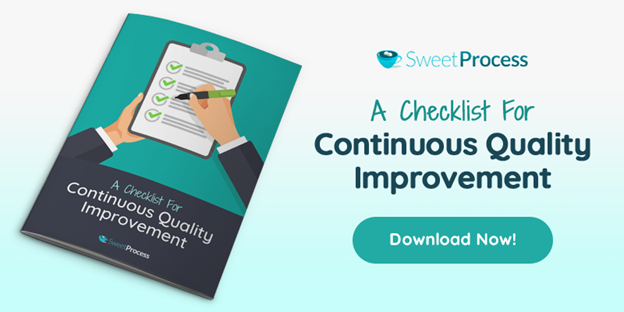
Get Your Free Systemization Checklist

5 Essential Steps To Getting a Task Out of Your Head and Into a System So You Can Scale and Grow Your Business!
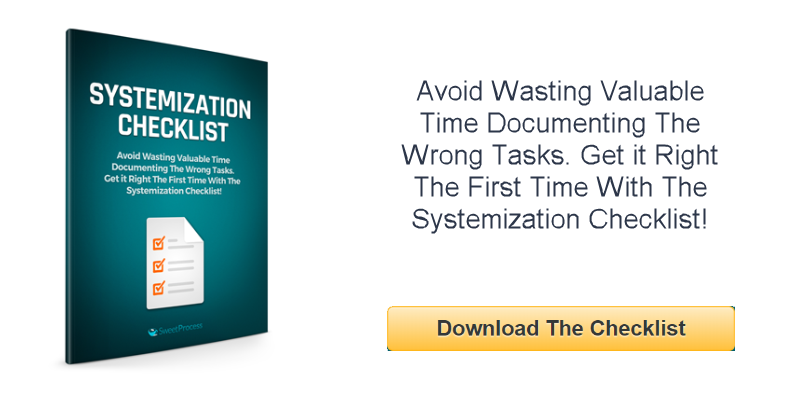
kincheloehositany78.blogspot.com
Source: https://www.sweetprocess.com/continuous-quality-improvement/
0 Response to "Which of the Following is Not Included in the Definition of Continuous Process Improvement Cqi"
Post a Comment